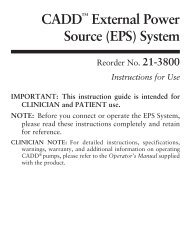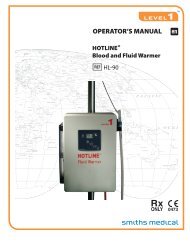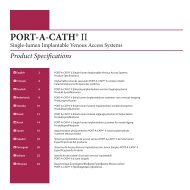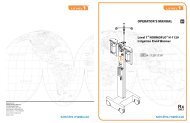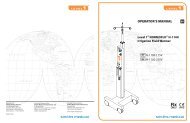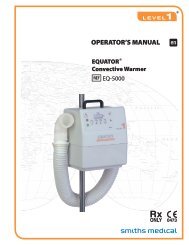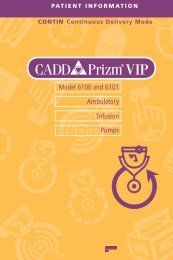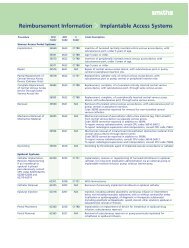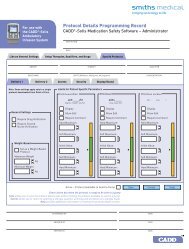40-5124-24C IFU, ProPort.indd - Smiths Medical
40-5124-24C IFU, ProPort.indd - Smiths Medical
40-5124-24C IFU, ProPort.indd - Smiths Medical
Create successful ePaper yourself
Turn your PDF publications into a flip-book with our unique Google optimized e-Paper software.
[pt] (continuação)<br />
E. Referências<br />
1.<br />
2.<br />
3.<br />
4.<br />
5.<br />
6.<br />
7.<br />
8.<br />
9.<br />
64<br />
10.<br />
Klotz HP, Schopke W, Kohler A, Pestalozzi B, Largiader F. Catheter Fracture: A Rare<br />
Complication of Totally Implantable Subclavian Venous Access Devices. J Surgical<br />
Oncol 1996; 62:222.<br />
Vadlamani P, Dawn B, Perry MC. Catheter Fracture and Embolization from Totally<br />
Implanted Venous Access Ports. J Vascular Dis 1998; 12:1013.<br />
Monsuez JJ, Douard MC, Martin-Bouyer Y. Catheter Fragments Embolization. J<br />
Vascular Dis 1997; 2:117.<br />
Ramsden WH, Cohen AT, Blanshard KS. Case Report: Central Venous Catheter Fracture<br />
Due to Compression Between the Clavicle and First Rib. Clinical Radiology 1995; 50:59.<br />
Coles CE, Whitear WP, Le Vay JH. Spontaneous Fracture and Embolization of a Central<br />
Venous Catheter: Prevention and Early Detection. Clinical Oncology 1998; 10:412.<br />
Kossoff EH, Poirier MP. Peripherally inserted central venous catheter fracture and<br />
embolization to the lung. Pediatric Emer Care 1998; 6:<strong>40</strong>3.<br />
Lafreniere R. Indwelling Subclavian Catheters and a Visit With the “Pinched-Off Sign”.<br />
J Surgical Oncol 1991; 47:261.<br />
Hinke DH, Zandt-Stastny DA, Goodman LR, Quebbeman EJ, Krzywda EA, Andris<br />
DA. Pinch-off Syndrome: A Complication of Implantable Subclavian Venous Access<br />
Devices. Radiology 1990; 177:353<br />
Franey T, Demarco LC, Geiss AC, Ward RJ. Catheter fracture and embolization in a<br />
totally implanted venous access catheter. J Parent Ent Nutr 1988; 12:528<br />
Moureau NL, McKinnon BT, Douglas CM. Multidisciplinary management of thrombotic<br />
catheter occlusions. J Vasc Acces Dev 1999; summer:22<br />
NOTA: A data de emissão destas Instruções de Utilização é incluída para<br />
informação do médico Se o intervalo de tempo entre a data de emissão e a<br />
utilização do produto for superior a um ano, o médico deverá contactar a<br />
Deltec, Inc. para verificar se se encontra disponível uma versão mais recente<br />
destas instruções.<br />
Data de Emissão: 2005-06<br />
Estes produtos descritos estão abrangidos por uma ou mais das seguintes Patente<br />
dos E.U.A, números: 4,723,948, 4,743,231, 4,880,414, 4,963,133, 5,387,192, 5,558,641, e<br />
5,613,945; outra(s) patente(s) pendente(s); patente(s) estrangeira(s) pendente(s).<br />
<strong>ProPort</strong>, SlideLock, CATH-SHIELD, PORT-A-CATH, e Low Profile são marcas registadas das<br />
empresas da família <strong>Smiths</strong> <strong>Medical</strong>. El simbolo indica que el producto está registrado<br />
en la Oficina de Patentes y Marcas Comercialea de ® EE.UU. y en algunos otros paises.<br />
© 2005 <strong>Smiths</strong> <strong>Medical</strong> família de empresas. Todos os direitos reservados.<br />
[it]<br />
INDICE PAGINA<br />
I. INTRODUZIONE .......................................................................................64<br />
A. Descrizione del prodotto ......................................................................................... 65<br />
B. Indicazioni per l’uso ................................................................................................. 65<br />
C. Controindicazioni .................................................................................................... 65<br />
D. Complicanze potenziali ........................................................................................... 65<br />
II. AVVERTENZE ........................................................................................... 65<br />
III. ISTRUZIONI SUL PRE-IMPIANTO ............................................................66<br />
A. Preparazione del sistema ......................................................................................... 66<br />
A.1 Sistemi smontati ............................................................................................... 66<br />
A.2 Sistemi pre-montati ......................................................................................... 66<br />
IV. TECNICHE DI POSIZIONAMENTO DEL CATETERE ..................................66<br />
A. Puntura percutanea – Metodo A (radiologi d’intervento) ............................... 66<br />
B. Puntura percutanea – Metodo B (chirurghi) ...................................................... 67<br />
C. Incisione chirurgica per approccio vascolare ..................................................... 67<br />
V. PREPARAZIONE DELLA PORTA E DEL SITO ............................................ 67<br />
A. Preparazione della tasca sottocutanea .................................................................. 67<br />
B. Gruppo catetere-porta ............................................................................................. 67<br />
B.1 Connettore SlideLock ................................................................................... 68<br />
B.2 Connettore CATH-SHIELD® ........................................................................ 68<br />
C. Controllo del flusso .................................................................................................. 68<br />
D. Sutura del sito ............................................................................................................ 68<br />
E. Assistenza post-operatoria ...................................................................................... 68<br />
VI. ISTRUZIONI PER L’ACCESSO AL SISTEMA ...............................................68<br />
A. Determinazione dell’integrità del sistema ........................................................... 68<br />
A.1 Integrità del sistema verificata – La porta non sarà usata<br />
immediatamente .............................................................................................. 69<br />
A.2 Integrità del sistema verificata – Inizio immediato dell’iniezione o<br />
dell’infusione .................................................................................................... 69<br />
B. Irrigazione .................................................................................................................. 69<br />
C. Procedimento per i prelievi del sangue ................................................................ 69<br />
D. Interruzione dell’uso del sistema ........................................................................... 70<br />
E. Bibliografia ................................................................................................................. 70<br />
FIGURE ............................................................................................................ 77<br />
I. INTRODUZIONE<br />
I sistemi di accesso venoso impiantabili <strong>ProPort</strong> possono essere posizionati in<br />
un braccio o nel torace e sono ideati per consentire l’accesso ripetuto al sistema<br />
venoso per la somministrazione parenterale di farmaci, fluidi e soluzioni nutritive,<br />
e per i prelievi del sangue venoso. Questi dispositivi devono essere impiantati<br />
esclusivamente da medici che abbiano acquisito esperienza nelle tecniche d’impianto<br />
e mantenimento dei dispositivi di accesso venoso e che siano a conoscenza dei<br />
rischi relativi.<br />
PRECAUZIONE: I pazienti che hanno occupazioni o svolgono attività fisiche<br />
quali golf, nuoto o sollevamento pesi comportanti un eccessivo e/o ripetitivo<br />
movimento rotatorio dell’estremità superiore e/o delle spalle o dell’area pettorale<br />
vanno informati che tale attività è suscettibile di aumentare la possibilità di<br />
frammentazione del catetere dovuta alla compressione del catetere stesso tra<br />
la clavicola e la prima costa.<br />
Le figure a cui si fa riferimento in questo manuale si trovano nella pagina ripiegata<br />
all’interno della copertina posteriore. Le specifiche sulla porta e sul catetere sono<br />
elencate nel foglio illustrativo fornito con il prodotto.<br />
Libretti informativi per il paziente e per il medico possono essere richiesti contattando



